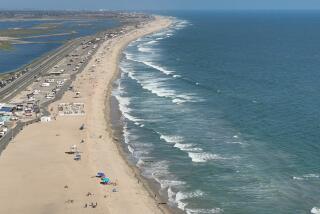1,000 Is Just a Number, Till You See the Crosses
- Share via
Every Sunday, the veterans come together to build “Arlington West” -- this one on the beach by the pier in Santa Barbara. There have been others, in Santa Monica, for instance. The veterans place a cross in the sand for every GI who’s been killed in Iraq. Laid out with military precision, the memorial is visually striking, a stark message left on the doorstep of an otherwise picture- perfect reality. And each weekend the memorial is larger than the week before.
Since its inception, a little less than a year ago, the number of crosses has more than tripled. It’s a powerful reminder of the cost of war and of those we’ve lost. The crosses themselves are well made. Twenty-four inches tall, 12 inches across, they’re made of Douglas fir, painted white. And they’re not blank. Each one is labeled with the name of a casualty, his or her place of birth, and where and often how he or she died. Sometimes there are wishes and remembrances from the family. They’re personalized. That’s what makes them so overwhelming.
My first encounter with Arlington West will remain in my memory for a long time to come. Santa Barbara is a beautiful place; the mountains and the sea come together here, with the pleasant town and quiet harbor nestled between -- hardly the place you’d expect to encounter the ultimate reality. The incongruity is emotionally wrenching.
Walking out into the memorial for the first time, I found myself overwhelmed with grief. One thousand casualties is just a number. One thousand crosses, with names and dates, will drive you to your knees like a sledgehammer.
I helped take down the memorial that day, at least partly to distract myself from that feeling of being overwhelmed. It’s a huge task, and there’s definitely a craft to it. A veteran showed me how to arrange the crosses, how to stack them in bundles of 16, how to tie them with cords left in the sand. I helped carry the bundles to the road, one in each hand. Those bundles are heavy, and they felt like an awkward burden -- until I reminded myself of what I was carrying. I watched the bundles stacked in the van, the way soldiers are packed into Humvees and Bradleys, pragmatically and without artfulness, but not without grace.
In the United States, we don’t have much contact with mortality, up close and personal. Death happens elsewhere, is dealt with elsewhere. It’s strange and upsetting to find it next to the sidewalk. A graveyard is usually a place that you leave the dead to lie, to separate yourselves from them. But here, there is no separation. Every week the soldiers are laid to rest, and every week they’re gathered up again.
Those who pass by react with sorrow, grief and often anger. For those involved in it, the ritual loses its original starkness, but it never becomes routine. Our soldiers’ deaths in Iraq used to be reported on the front page, above the fold. But the war has been going on so long that casualties are no longer front-page news; they’re reported in the text of some other story, if indeed they’re reported at all. Their coffins are unloaded in the dead of night; their memorial is not yet built. The public has moved on.
But here in Santa Barbara, the veterans don’t forget. They spend their weekends, without recompense, performing this serious and simple ritual. In a space usually populated by sunbathers, they create a memorial as powerful in its way as the Vietnam Veterans Memorial in Washington. They give a presence to the dead, and the dead themselves inform us with this message: This is the cost of what we do.
More to Read
Sign up for The Wild
We’ll help you find the best places to hike, bike and run, as well as the perfect silent spots for meditation and yoga.
You may occasionally receive promotional content from the Los Angeles Times.






